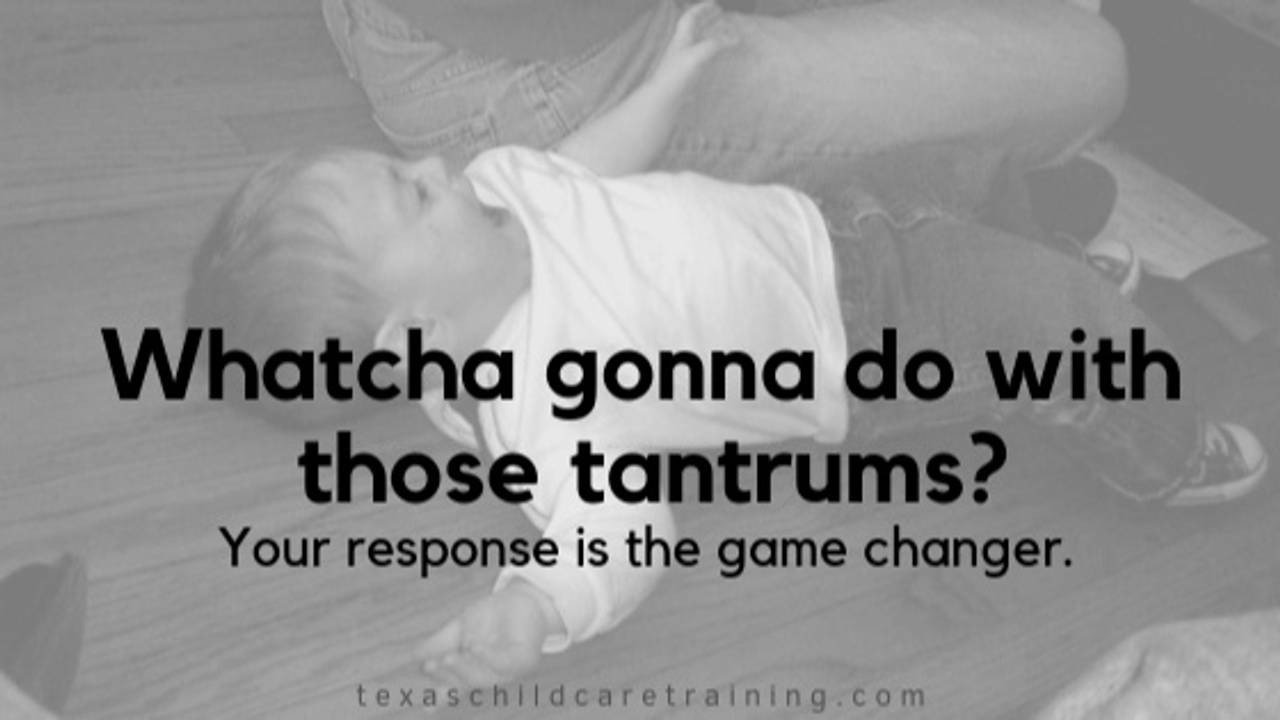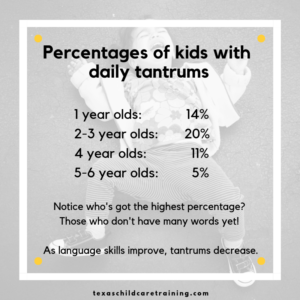About those tantrums…
Dec 16, 2018
You’re a teacher in the 3-yr-old class and it’s time to go outside to play. You give a 5-minute warning and after cleaning up together, you sing a transition song to direct children to cubbies to put on their coats for the playground. One little boy is having trouble getting his coat on but insists on doing it himself. The third time his arm gets caught in the sleeve, he falls to the ground in frustration, yelling, crying inconsolably and thrashing out when you try to help.
The reaction in the room is palpable. The other children appear nervous, and you feel a range of emotions – frustration at the seeming overreaction, helplessness, concern for other children, feeling like others will hear what’s going on and think you can’t control the class and fear of parents’ reactions if someone walks in at this moment.
We’ve all been there. You just don’t know what to do next. And it seems like what you do try doesn’t work, especially when you’ve got a kid on the floor screaming, thrashing and crying like there’s no tomorrow because they can’t get their coat on.
Lucky for us, like most things with young children, we can turn to child development to understand what’s going on. When we understand that this is normal, typical behavior and have a few tools in our pocket to pull out in the heat of the moment, that tantrum becomes less of a day-ruiner for everyone, especially the poor kid feeling those gigantic, scary, overwhelming emotions.
In studies of typically developing children, anger is what we SEE in a temper tantrum, although it is not the primary emotion. The primary emotions are fear and sadness. Anger is a fight or flight reaction to a trigger in the internal or external environment of the child.
Tantruming children are experiencing distress or extreme anxiety. Anxious and overwhelmed, there is nowhere for the emotions to go. They simply don’t have the ability yet to adequately express them. Feeling completely inundated by inconsolable emotions, a child becomes very distressed. And it looks like anger.
Tantrums are normal in young children. It doesn’t mean you’ve done something wrong. The child melting down likely does NOT have emotional problems, ADD or any other disorder – they are simply very goal directed. And their goal is different from yours at the moment.
Let’s take a look at some facts about tantrums:
- They are equally common in boys and girls.
- They are a normal part of child development.
- They communicate a desire for independence and control over their environment.
- They diminish as language skills emerge.
Those 2-3 year olds who have difficulty getting others to understand what they’re trying to communicate have the most tantrums! As language skills improve, tantrums decrease.
- Wanting something you can’t have
- Having to do something somebody else wants you to do
- Not being able to do what you want to do
What NOT TO DO during the meltdown:
- Ask what they’re upset about
- Get angry yourself
- Say “use your words” to the child
- Demean or correct the child, telling them of how scared they made the other children feel
What TO DO:
- Give the child as much space and time as possible to let the emotions pass
- Understand the rhythm of a tantrum. Wait for the anger to subside and console their sadness.
- Demonstrate empathy.
- Give words to the feelings. “You are upset because you can’t get your coat on by yourself and you don’t want me to help you.”
- Affirm the child’s budding ability to express their emotions in a way that others can understand. Use the tantrum as an opportunity for learning.
Next time a child throws a tantrum, take a breath and remember your plan: give space and time for it to pass, don’t ask the child questions, wait for the big anger to subside and demonstrate empathy. Then move on to the next thing.
Later, when things are calm, talk with the child and create a plan for when they feel big feelings. Will a 3-year-old remember that plan next time? Probably not. Watch for the preemptive signs of the meltdown and gently guide the child towards the plan BEFORE the big emotions hit.
Let’s be real. You’re not going to be able to avoid tantrums completely if you work with young children. But you can understand more about them. And you can plan on how YOU will respond – with understanding, demonstrating empathy and kindness.
By keeping developmental needs in mind, you’ll understand that little ones are figuring out how to have a little control in their world when they express frustration, anxiety, and sadness. You can show children you understand them and love them no matter what.
You’re no longer helpless, overwhelmed and fed up by tantruming kids. You are equipped and knowledgeable. You get children and you understand what’s going on. Kind of. Sometimes.
Click here for practical tips for preventing tantrums and what to do while it’s happening.
Stay connected with news and updates!
Join our mailing list to receive the latest news and updates from our team.
Don't worry, your information will not be shared.
We hate SPAM. We will never sell your information, for any reason.


